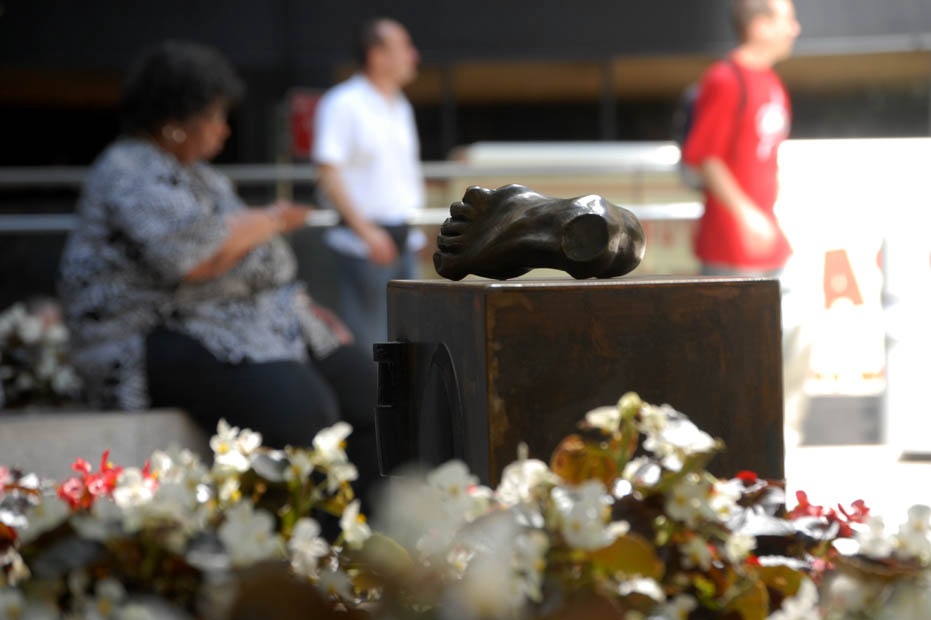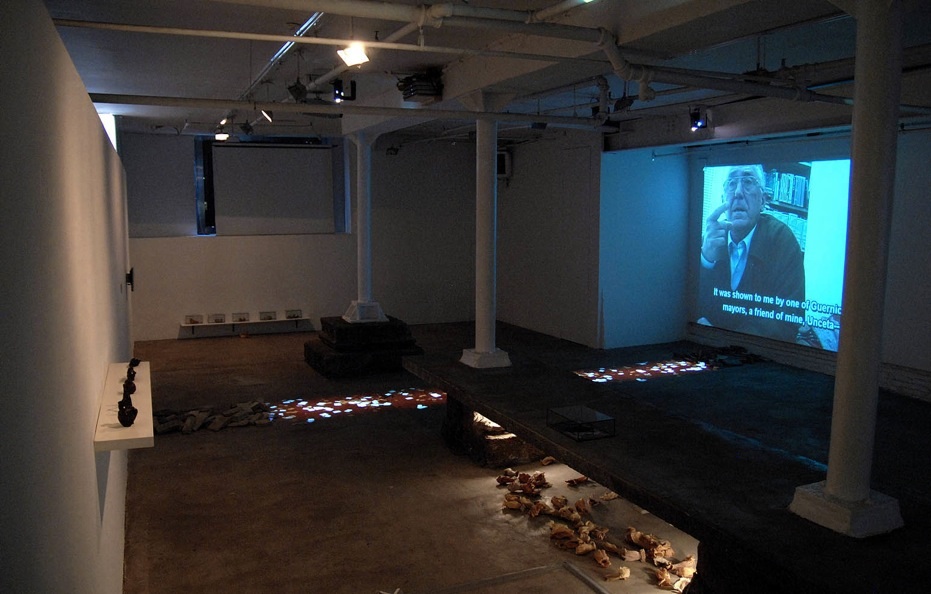
By Abigail Wender
Anita Glesta’s multimedia installation Gernika/Guernica opens at the new Museum of Contemporary Art Krakow (MOKAK) this Friday, October 19, to commemorate the 75th anniversary of the Gernika bombing. Her visually dramatic and bold installation encompasses two galleries and an outdoor courtyard, filling them with motion-activated sculptures, taped interviews, and videos that explore connections between the historic bombing of the Basque village, Picasso’s mural of the event, and the attack on the World Trade Center in 2001.
Glesta, an artist known for her public work, was living with her husband and children in Battery Park City when the World Trade Center was attacked. As the first plane flew into the Trade Center, she was looking out her 32nd story bedroom window. Glesta writes in an essay accompanying the installation, “I ran to save my children from the school, which was beneath the Towers, trying to shelter them from the horror of what they were seeing as we fled up West Street.”
In the months following the attack, Glesta was asked by the Lower Manhattan Arts Council to formulate a piece in response to 9/11. Not unlike survivors of a bombing, she and her family were without a home and moved from apartment to apartment. Picasso’s Guernica and the image of a tortured horse—perhaps the world’s most recognized symbol of suffering inflicted on innocent civilians, haunted her. Glesta, who had lived in Spain as a teenager, sent an email to Gernika Gogoratuz, the Peace Research Centre in Gernika, Spain, hoping to speak with someone there. She received an immediate response from Maria Oinguren, the Director, who had expected September 11 survivors to make contact. She wrote to Glesta: “We’ve been waiting for you.”
Glesta… sent an email to Gernika Gogoratuz, the Peace Research Centre in Gernika, Spain, hoping to speak with someone there. She received an immediate response from Maria Oinguren, the Director, who had expected that September 11 survivors to make contact. She wrote to Glesta: “We’ve been waiting for you.”
Their correspondence began what became a five-year project for Glesta. She visited the village of Gernika, sometimes as often as twice a year, and spoke often as a survivor and an artist at their peace conference. Glesta began to interview and videotape the Gernika bombing survivors, people in their late 70s and 80s. Portions of these interviews make up segments of the installation, in which Glesta juxtaposes images of art and history, and attempts to locate the attack on the World Trade Center in a larger context.
Glesta’s Gernika/Guernika combines images from Picasso’s painting, recordings of testimonies of bombing survivors, along with her sculptural work and video footage. In the courtyard, eight large motion-activated radio boxes project a narrative moment of survivors’ testimony in Spanish, English, and now in Polish. Her handsome bronze sculptures of old-fashioned radios recall communications in a pre-digital age, and create an intimate story for the viewer. On top of the radios are smaller sculptures—such as a severed hand, a foot, an oak leaf, a heart, a bird’s claw—that bring images from Picasso’s mural and the catastrophes of Guernica and 911 into conversation.
In two adjoining rooms, Glesta’s videos and interviews project across the walls and floors. The video loop “Dark Cloudy Sky” is interrupted by a one-second image of blue sky. This is “the gap,” Glesta explains, where the World Trade Center stood filmed on September 12, 2001. On three small monitors play loops of horses and bulls, 1930 footage of the Spanish Civil War, and video footage Glesta also filmed from her apartment window on September 12. In the second room the video “River of Blood” projects a crimson red stream with fluttering pieces of white paper across a wall and floor, accompanied by a documentary of interviews with Basque survivors.
In each installation the viewer is aware of the contrast between sensual, lyric and horrifically violent imagery, between what is art and what is documentary footage, and the blurring that occurs between these. There is also a theatrical element to Glesta’s work. Calling the memories of the survivors, “sacred truths,” she writes in an essay accompanying the exhibit, “they contain more human truth and resonance than any architectural memorial can convey.” Testimony “can reveal that [the] feeling of loss is universal.” The viewer walking through this installation asks the same questions that Glesta poses and many others have faced: “What does it mean to be making art in these terrible times, particularly in the context of a memorial . . . what [does] it mean to make images of atrocity?”
First presented in New York City at White Box in Chelsea and Chase Manhattan Plaza, the installation Gernika/Guernica at MOCAK includes further testimonies from two Holocaust survivors in recognition of the museum’s historical location, the Oskar Schindler Factory. The location gives a permanent frame to the museum’s stated goal—to show the relevance and ethical importance of avant-garde art in the post-World War II world.
Gernika/Guernica will be seen at MOCAK, Poland through January 27, 2013, before moving to the Sackler Museum Beijing to open the new Contemporary Art Gallery.
Abigail Wender is a teacher, poet and translator. Her poems have appeared in the New Orleans Review, Massachusetts Review, and others, and is currently working on a group of translations of the German poet, Sarah Kirsch, and a manuscript titled, The Other-branch.

